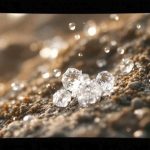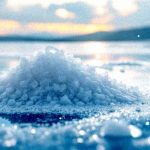Takeaways
- Sodium chloride balances fluids in the body
- It helps transmit nerve signals effectively
- Proper intake supports overall health
- Excess consumption can lead to health issues
- It has many uses beyond nutrition
What Is Sodium Chloride?
Sodium chloride is a mineral compound formed from sodium and chloride ions and is commonly known as table salt.[1] It’s a substance that appears in many everyday applications.
Sodium chloride is naturally abundant, found in large quantities in seawater and also in rock deposits. Industries extract it through various methods to supply demand.
Salt is obtained by evaporating seawater and mining rock salt deposits.[2] Pure sodium chloride can also be created through chemical processes, ensuring a consistent supply for diverse uses.[3]
Sodium Chloride in the Human Body
Fluid Balance
Sodium chloride helps maintain fluid balance in the human body by regulating the water content both inside and outside of cells.[4] This balance is crucial for proper bodily functions.
The process of osmosis, which involves water movement across cell membranes, is driven by sodium chloride.[5] This action helps cells maintain the correct amount of water, preventing dehydration or swelling.
Sodium chloride plays a role in:
- Blood volume regulation
- Cellular hydration
- Nutrient absorption in the gut
- Waste removal from cells
Nerve Function
Nerve impulse transmission relies on sodium chloride.[6] Nerves utilize sodium and chloride ions to send signals that control movement and senses.
Action potentials, which are electrical impulses traveling along nerve fibers, depend on sodium and chloride. Sodium enters the cell, while chloride exits, creating the electrical signal.[7]
Proper nerve function, which affects muscle movement and our ability to feel sensations, relies on appropriate levels of sodium chloride to keep the nervous system operating effectively.
Nutritional Importance
Recommended Intake
Health organizations provide guidelines for sodium chloride intake, varying by age, sex, and health conditions. Most adults should aim to limit sodium intake to 2,300 mg daily.[8]
Different populations need varying amounts of sodium. For example, people with high blood pressure might need less, while athletes who sweat more may require more.[9] Pregnant women also have specific needs.
| Group | Daily Sodium Chloride Recommendation |
|---|---|
| Adults | 2,300 mg |
| Children (4-8 years) | 1,900 mg |
| Adults over 50 | 1,500 mg |
| People with hypertension | 1,500 mg |
Deficiency and Excess
While uncommon, a deficiency of sodium chloride can be a serious condition. Symptoms include:
- Headache
- Nausea
- Muscle cramps
- Confusion
- Fatigue
Excessive sodium chloride intake is more prevalent and can lead to:
- High blood pressure
- Increased risk of heart disease
- Kidney problems
- Stomach cancer risk
Maintaining the right balance of sodium chloride is important, since too little or too much can be harmful. Moderation is best for most individuals.
Culinary Uses
Flavor Enhancement
Sodium chloride enhances the flavors of foods by bringing out their inherent tastes.[10] It can make sweet foods taste sweeter and reduce bitterness in some cases.
Salt strongly affects taste buds, activating receptors on the tongue. This activation sends signals to the brain which then interprets these signals as flavor.[11]
Salt is important in:
- Baking (bread, pastries)
- Meat preparation
- Vegetable dishes
- Soups and stews
Preservation
For thousands of years, people have used salt to preserve food. Salt draws water out of food, creating an environment where bacteria cannot easily grow and extending its shelf life.[12]
Sodium chloride creates unfavorable conditions for microbes by decreasing water activity in food. Many harmful bacteria struggle to survive in these low-moisture environments.
Salt is still used for food preservation today. Examples include:
- Cured meats
- Pickled vegetables
- Salted fish
- Some cheeses
Industrial Applications
Water Treatment
Water treatment plants use sodium chloride to remove minerals from hard water, a process known as water softening.
Hard water contains calcium and magnesium that can create deposits in pipes and appliances, while soft water, treated with sodium chloride, prevents such issues.
The benefits of using sodium chloride in water treatment include:
- Extends appliance lifespan
- Improves soap and detergent effectiveness
- Reduces scale buildup in pipes
- Makes water feel smoother
De-icing
Road crews use sodium chloride on icy roads to lower the freezing point of water, helping to melt existing ice and prevent new ice from forming.[13]
When salt dissolves in water, it creates a solution that has a lower freezing point compared to pure water, resulting in safer roads during the winter.
The use of road salt also has environmental implications including:
- Harm roadside plants
- Affect soil composition
- Contaminate freshwater sources
- Corrode vehicles and infrastructure
Finding a balance between road safety and environmental protection remains an ongoing challenge.
Medical Uses
Oral Rehydration Therapy
Sodium chloride solutions are used by doctors to treat dehydration through oral rehydration therapy, which is effective for mild to moderate cases.[14]
Oral rehydration solutions include salt and sugar which are absorbed by the body better than plain water, helping restore fluid balance faster.
Oral rehydration is helpful in situations such as:
- Diarrhea
- Excessive sweating
- Vomiting
- Heat exhaustion
Intravenous Fluids
Hospitals use sodium chloride solutions in intravenous (IV) fluids to treat severe dehydration and to administer medications.[15]
Different concentrations of sodium chloride serve specific purposes. Normal saline (0.9%) is used because its composition matches body fluids closely, while other concentrations treat specific conditions.
| IV Fluid Type | Sodium Chloride Concentration | Common Uses |
|---|---|---|
| Normal Saline | 0.9% | General fluid replacement |
| Half-Normal Saline | 0.45% | Mild dehydration |
| Hypertonic Saline | 3% or higher | Severe hyponatremia |
Environmental Impact
Ocean Salinity
Sodium chloride is a major component of ocean water that helps maintain the equilibrium of marine ecosystems.[16] Changes in salinity can have an impact on sea life.
Ocean currents distribute salt around the world. This has an effect on climate patterns and influences marine biodiversity.[17]
Climate change could alter ocean salinity, potentially leading to:
- Changes in ocean circulation
- Shifts in marine species distribution
- Alterations in global weather patterns
Scientists are carefully monitoring changes to salinity in the oceans. Understanding these shifts helps predict climate trends.
Soil Health
Sodium chloride can also affect soil quality. High salt levels in soil can harm plants, especially in coastal areas and regions using road salt.[18]
Excess salt in soil can result in:
- Reduced water absorption by plants
- Nutrient imbalances
- Decreased soil structure
- Lower crop yields
Methods to mitigate the harmful effects of salt on soil include:
- Improved drainage systems
- Salt-tolerant plant varieties
- Careful irrigation practices
- Soil amendments to counter salt effects
Balancing human requirements with the need to maintain healthy soil is a constant challenge.
Sodium Chloride Alternatives
Low-Sodium Options
Many people seek alternatives to sodium chloride, often for health reasons.[19] There are a number of options that can add flavor without as much sodium.
Popular low-sodium seasonings include:
- Potassium chloride
- Herb blends
- Citrus juices
- Vinegars
- Spice mixes
These alternatives offer a variety of flavor profiles, some mimicking salt’s taste while others provide new tastes to enhance food.
Health Considerations
Reducing sodium intake is beneficial for certain health conditions, such as high blood pressure. Heart and kidney disease patients may also benefit.[20]
Adjusting to a low-sodium diet takes time. Taste buds adapt gradually. Food may seem bland at first, but this usually improves over time.
Tips for reducing sodium consumption include:
- Read food labels carefully
- Cook more meals at home
- Use herbs and spices for flavor
- Rinse canned vegetables
- Choose fresh or frozen foods over processed ones
Frequently Asked Questions
Is sodium chloride the same as table salt?
How much sodium chloride should I consume daily?
Can I use sodium chloride for gargling?
Does sodium chloride raise blood pressure?
Is sea salt healthier than regular sodium chloride?
Conclusion
Sodium chloride is vital in our daily lives for balancing body fluids and supporting nerve function, as well as its uses in cooking, food preservation, and other industrial applications.
Appropriate sodium chloride intake is essential for overall health; however, excessive intake can cause problems. It’s important to find the right balance, considering individual health needs.
Here are some ways to use sodium chloride wisely:
- Monitor your daily intake
- Choose fresh foods over processed ones
- Use other seasonings to add flavor
- Read food labels to track sodium content
- Consult a doctor about your specific needs
Table salt is indeed the common name for the chemical compound sodium chloride (NaCl). This compound is an ionic compound consisting of positively charged sodium ions (Na+) and negatively charged chloride ions (Cl-).
Source: “Dielectric characterization and modelling of aqueous solutions involving sodium chloride and sucrose and application to the design of a bi-parameter RF-sensor” https://www.ncbi.nlm.nih.gov/pmc/articles/PMC9065094/
Both methods are common ways to obtain salt. Solar evaporation harnesses the sun’s energy to evaporate seawater, leaving behind salt crystals. Mining involves extracting salt from underground deposits.
Source: “Replacing salt with low‐sodium salt substitutes (LSSS) for cardiovascular health in adults, children and pregnant women” https://www.ncbi.nlm.nih.gov/pmc/articles/PMC9363242/
While the majority of table salt is sourced from natural deposits and seawater, chemically synthesized sodium chloride is necessary for applications where high purity is required.
Source: “Replacing salt with low‐sodium salt substitutes (LSSS) for cardiovascular health in adults, children and pregnant women” https://www.ncbi.nlm.nih.gov/pmc/articles/PMC9363242/
Sodium ions are the primary regulator of extracellular fluid volume, while chloride ions follow the sodium ions to maintain balance. This balance affects cell hydration.
Source: “Quality of fluid balance charting and interventions to improve it: a systematic review” https://www.ncbi.nlm.nih.gov/pmc/articles/PMC10729040/
Sodium concentration differences across cell membranes create osmotic gradients, causing water to move in or out of cells to equalize concentrations. Chloride often follows, adding to the effect.
Source: “Removal of Heavy Metals from Wastewaters and Other Aqueous Streams by Pressure-Driven Membrane Technologies: An Outlook on Reverse Osmosis, Nanofiltration, Ultrafiltration and Microfiltration Potential from a Bibliometric Analysis” https://www.ncbi.nlm.nih.gov/pmc/articles/PMC11355994/
Nerve signals are electrical, and sodium and chloride are two of the main ions responsible for creating the electrical signals in nerve cells.
Source: “Large, Stable Spikes Exhibit Differential Broadening in Excitatory and Inhibitory Neocortical Boutons” https://www.ncbi.nlm.nih.gov/pmc/articles/PMC7809622/
While sodium influx is a key step in depolarization, chloride ions typically move into the cell, causing inhibition. It should be noted, the overall action potential is more complex, involving other ions like potassium
Source: “Large, Stable Spikes Exhibit Differential Broadening in Excitatory and Inhibitory Neocortical Boutons” https://www.ncbi.nlm.nih.gov/pmc/articles/PMC7809622/
The Dietary Guidelines for Americans recommends that adults limit sodium intake to less than 2300 mg per day. Individuals with certain health conditions might need to limit it even further.
Source: “Dietary Guidelines for Americans, 2020–2025: Understanding the Scientific Process, Guidelines, and Key Recommendations” https://www.ncbi.nlm.nih.gov/pmc/articles/PMC8713704/
Individuals with conditions like high blood pressure or kidney disease are often advised to reduce sodium intake, whereas athletes may require more due to sweat loss.
Source: “Higher versus lower sodium intake for preterm infants” https://www.ncbi.nlm.nih.gov/pmc/articles/PMC10569379/
Salt can make foods taste sweeter, suppress bitterness, and enhance other flavors, making food more palatable. This effect is due to the way salt interacts with taste receptors and the brain’s flavor interpretation.
Source: “Sodium Intake and Disease: Another Relationship to Consider” https://www.ncbi.nlm.nih.gov/pmc/articles/PMC9921152/
Sodium chloride interacts with specific receptors on the taste buds, primarily through the sodium component. This interaction leads to neural signals that the brain interprets as the salty taste, which then contributes to the perception of overall flavor.
Source: “Sodium Intake and Disease: Another Relationship to Consider” https://www.ncbi.nlm.nih.gov/pmc/articles/PMC9921152/
Salt reduces water activity (available water) in food. This hinders bacterial growth, since they need water for their metabolic activities. Historically, salt curing was crucial for preserving food before refrigeration.
Source: “Replacing salt with low‐sodium salt substitutes (LSSS) for cardiovascular health in adults, children and pregnant women” https://www.ncbi.nlm.nih.gov/pmc/articles/PMC9363242/
When salt dissolves in water, it creates a solution with a lower freezing point than pure water. This helps to melt ice on roads and prevent the formation of new ice, enhancing road safety in cold weather.
Source: “Trace metals in Northern New England streams: Evaluating the role of road salt across broad spatial scales with synoptic snapshots” https://www.ncbi.nlm.nih.gov/pmc/articles/PMC6373959/
Oral rehydration solutions contain specific amounts of sodium and sugar. The sodium helps with fluid absorption and balance.
Source: “A Review on In Vivo Research Dehydration Models and Application of Rehydration Strategies” https://www.ncbi.nlm.nih.gov/pmc/articles/PMC11510460/
Intravenous saline solutions, often normal saline (0.9%), are used in hospitals to rehydrate patients and deliver drugs intravenously. Various concentrations of sodium chloride solutions exist for different treatment purposes.
Source: “Knowledge and practice towards intravenous fluid therapy in children among nurses in the pediatrics emergency department of selected public hospitals” https://www.ncbi.nlm.nih.gov/pmc/articles/PMC10828392/
The concentration of sodium chloride in the ocean has an influence on the density, osmotic pressure, and electrical conductivity of the water, which are critical for maintaining homeostasis within marine habitats.
Source: “Does climate change transform military medicine and defense medical support?” https://www.ncbi.nlm.nih.gov/pmc/articles/PMC10194660/
Ocean currents help to move salt around the globe. The distribution of salt has implications for ocean density and circulation, influencing global climate. Salt content also is a factor in the types of marine life that inhabit various parts of the ocean.
Source: “Impact of bathymetry on Indian Ocean circulation in a nested regional ocean model” https://www.ncbi.nlm.nih.gov/pmc/articles/PMC10997594/
Excessive salt can disrupt water absorption by plant roots (osmotic stress), causing dehydration and nutrient imbalances. It also has an impact on soil structure.
Source: “Strategies for combating plant salinity stress: the potential of plant growth-promoting microorganisms” https://www.ncbi.nlm.nih.gov/pmc/articles/PMC11284086/
Due to its connection with hypertension and cardiovascular disease, consumers often seek lower-sodium replacements, but it is still the most common form of salt used for flavoring.
Excess sodium can contribute to fluid retention, increased blood volume, and elevated blood pressure, all of which can exacerbate these conditions. It can also have negative effects on kidney function.
Source: “Sodium in the New Zealand diet: proposed voluntary food reformulation targets will not meet the WHO goal of a 30% reduction in total sodium intake” https://www.ncbi.nlm.nih.gov/pmc/articles/PMC9363297/
The recommendation for most adults is to limit sodium intake to less than 2300mg daily, which is equivalent to about a teaspoon of table salt, however, individuals should pay attention to recommendations from their healthcare providers.
Source: “Dietary Guidelines for Americans, 2020–2025: Understanding the Scientific Process, Guidelines, and Key Recommendations” https://www.ncbi.nlm.nih.gov/pmc/articles/PMC8713704/
High sodium intake increases fluid retention, which can then raise blood pressure. Maintaining a moderate intake is essential to promoting cardiovascular health.
Source: “Sex differences in blood pressure regulation and hypertension: renal, hemodynamic, and hormonal mechanisms” https://www.ncbi.nlm.nih.gov/pmc/articles/PMC11281816/
Both table salt and sea salt are primarily sodium chloride. Sea salt might contain some trace minerals, but the amounts are generally insignificant compared to other dietary sources. Health impacts are essentially the same.
Source: “Replacing salt with low‐sodium salt substitutes (LSSS) for cardiovascular health in adults, children and pregnant women” https://www.ncbi.nlm.nih.gov/pmc/articles/PMC9363242/



